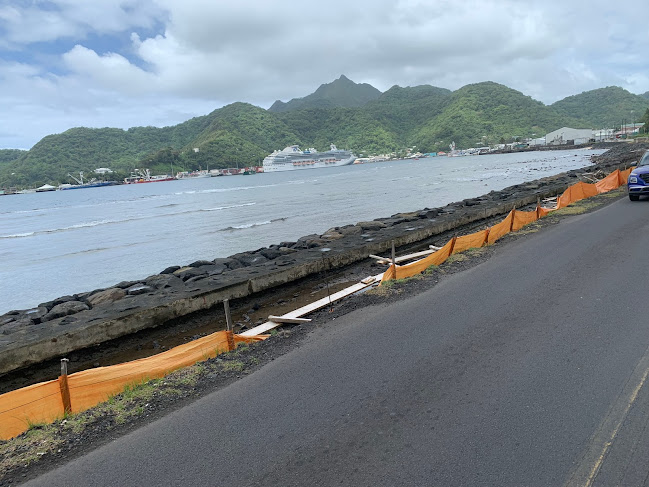AMERICAN SAMOA
PAGO PAGO
The history of American Samoa is a complex and
rich narrative that involves indigenous culture, European exploration,
colonization, and its current status as an unincorporated territory of the
United States.
- Indigenous Settlement: The islands of American Samoa were
inhabited by Polynesian peoples for thousands of years before European
contact. These indigenous peoples developed their own cultures,
traditions, and social systems on the islands.
- European Exploration: The first recorded European contact
with the islands occurred in the 18th century when Dutch explorers
arrived. Later, in the 19th century, American and British explorers,
including Captain James Cook, visited the islands.
- Missionary Influence: Christian missionaries, particularly
from the United States, arrived in the mid-19th century and had a
significant impact on the islands' culture and society. The influence of
Christianity remains strong in American Samoa to this day.
- German and American
Influence: In the late 19th
century, Germany and the United States established colonial interests in
the Pacific region, including Samoa. The islands were divided between the
two powers: Germany controlled what is now Samoa (formerly Western Samoa),
while the United States took control of eastern Samoa, which includes what
is now American Samoa.
- Treaty of Berlin: The Treaty of Berlin in 1899 officially
divided the Samoan archipelago between Germany and the United States.
American Samoa was established as a U.S. naval station and later as a
coaling station. The islands remained under U.S. naval administration for
several decades.
- Naval Administration: The U.S. Navy governed American Samoa
from 1900 to 1951. During this period, efforts were made to promote
economic development, modernize infrastructure, and introduce education.
- Transition to Civilian Government: In 1951, administration of American
Samoa was transferred from the U.S. Navy to the U.S. Department of the
Interior. The islands' inhabitants were granted U.S. citizenship, and a
civilian government was established.
- Cultural Preservation: Throughout its history, American Samoa
has worked to preserve its indigenous culture and traditions in the face
of external influences. Efforts have been made to maintain the Samoan
language, traditional arts, and customs.
- World War II: During World War II, American Samoa
played a strategic role as a military base for the United States in the
Pacific theater.
- Current Status: American Samoa remains an
unincorporated territory of the United States. The islands have their own
local government with a governor and a territorial legislature. American
Samoans are U.S. nationals, which grants them certain rights but not full
U.S. citizenship unless they move to the U.S. mainland.
- Economic Development: The economy of American Samoa has
traditionally been based on subsistence agriculture and fishing, but in
recent decades, the tuna canning industry has become a significant driver
of the local economy.
- Cultural Identity: The people of American Samoa have
managed to maintain a strong sense of cultural identity while integrating
aspects of modern life. Traditional communal and familial structures
continue to be an integral part of Samoan society.
Pago Pago (pronounced Pango Pango) is one of the most dramatic harbours in the South Pacific. Eons ago, the massive seawall of a volcano collapsed and the sea poured in. Today, towering mountain peaks encircle the deep harbour. The people who live on this island are settled pretty well entirely on its perimeter with the sea. Behind them are towering tree-clothed cliffs of the original volcano referred to above. If climate change brings sea level rise of two metres they will need to construct new roads and new homes. The current roads and sea walls were built by the Americans during the Second World War and are still in great condition.
Princess was offering a two and a half hour tour on quaint island buses for $160 each. We walked out to find local operators providing much the same tour charging $30 each in equally quaint buses and the tour was excellent, although the discomfort of wooden seats was perhaps the price you pay for economy.
Samoans are highly religious people. Substantial churches of all denominations stood guard around the perimeter. Religious symbols are everywhere including in the front yards of many houses where mausoleums are constructed for family who have died. An odd practice from a Western perspective but very practical. Flat land is at a premium on this island. Why waste it on a cemetery! A taxi stood by with a sign painted on its boot - God is my Provider!
One of the big employers on Pango Pango (as the locals pronounce it) is a very large fish processing plant. We drove by as the workers in aprons and hats were spilling from the factory. Perhaps Pongo Pongo would be a more appropriate name for this Tuna processing facility!
We have previously been to Apia in Western Samoa, so this was a new and interesting experience. Although, I spoke with a client from Western Samoa when he sought JP services from me in Brisbane. I told him we would be visiting Pago Pago in American Samoa and he said, “We are all the same! We visit each other.”










Pong! Glad I wasn’t at the fish place 🤢 Nice pic of Mum! Beautiful scenery! Happy sailing.
ReplyDelete